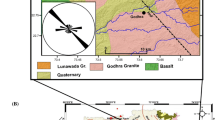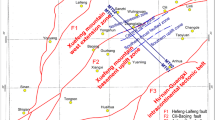Abstract
A magnetotelluric (MT) survey has been conducted in the eastern part of the Kachchh region of Gujarat State (crossing Little Rann) starting from Adesar village in the north to Enjar village in the south, where limited geophysical data is available. The profile has been acquired in the N–S direction having a total length of 52 km with the interstation spacing of 3–4 km. From two-dimensional (2D) inversion of the MT data, four conductive zones are identified. The analysis reveals that the depth of the basement varies from 1.2 km (in the south) to 1.8 km (in the north). The first conductive zone is found at a distance of ~ 3 km in the south of Adesar and is identified at the location of the Kanmer fault [KF; the eastern extension of South Wagad fault (SWF)] and might be the KF. The second conductive zone is found at a distance of ~ 42 km in the south of Adesar and ~ 13 km north of Enjar village and is located at the contact zone of Kachchh and Saurashtra peninsula at the location of the North Kathiawar fault (NKF). It is inferred as the NKF. The third conductive zone (at a distance of ~ 27 km in the south of Adesar) is found between the first and second conductor. This is interpreted as a step fault, formed during the rifting process of Kachchh. The lower crust (below 20 km) is found conductive (~ 120 Ω m) and might indicate the presence of fluid-filled mafic/ultramafic rocks in the lower crust.
















Similar content being viewed by others
References
Alabi, A. O., Camfield, P. A., & Gough, D. I. (1975). The North America central plains conductivity anomaly. Geophysical Journal International, 43, 815–833.
Arora, B. R., Rawat, G., & Singh, A. K. (2002). Mid-crustal conductor below the Kutch rift and its seismogenic relevance to the 2001 Bhuj earthquake (pp. 22–24). New Delhi: DCS-DST News Govt. of India.
Bahr, K. (1988). Interpretation of the magnetotelluric impedance tensor: regional induction and local distortion. Journal of Geophysics, 62, 119–127.
Bahr, K. (1991). Geological noise in magnetotelluric data: A classification of distortion types. Physics of the Earth and Planetary Interiors, 66(1–2), 24–38.
Becken, M., & Burkhardt, H. (2004). An ellipticity criterion in magnetotelluric tensor analysis. Geophysical Journal International, 159(1), 69–82.
Biswas, S. K. (1987). Regional tectonic framework, structure and evolution of the western marginal basins of India. Tectonophysics, 135(4), 307–327.
Biswas, S. K., Bhasin, A. L., & Ram, J. (1994). Classification of sedimentary basins of India in the framework of plate tectonics. Proceedings of the Second Symposium on the Petroliferous basins of India, KDMIPE, Dehradun, vol. 1, pp. 1–42.
Biswas, S. K. (2005). A review of structure and tectonics of Kutch basin, western India, with special reference to earthquakes. Current Science, 88(10), 1592–1600.
Biswas, S. K. (2016). Tectonic framework, structure and tectonic evolution of Kutch Basin, Western India. Special Publications Geological Society of India, 6, 129–150. https://doi.org/10.17491/cgsi/2016/105417.
Brasse, H., Lezaeta, P., Rath, V., Schwalenberg, K., Soyer, W., & Haak, V. (2002). The Bolivian Altiplano conductivity anomaly. Journal of Geophysical Research, 107(B5), 4–10. https://doi.org/10.1029/2001jb000391.
Chandrasekhar, D. V., & Mishra, D. C. (2002). Some geodynamic aspects of Kachchh basin and seismicity: An insight from gravity studies. Current Science, 83(4), 492–498.
Chopra, S., Chang, T. M., Saikia, S., Yadav, R. B. S., Choudhury, P., & Roy, K. S. (2014). Crustal structure of the Gujarat region, India: New constraints from the analysis of teleseismic receiver functions. Journal of Asian Earth Science, 96, 237–254.
Cox, K. G. (1993). Continental magmatic underplating. Philosophical Transactions of the Royal Society of London, 342(1663), 155–166.
Duba, A. G., & Shankland, T. J. (1982). Free carbon and electrical conductivity in the Earth’s mantle. Geophysical Research Letters, 9, 1271–1274.
Ferry, J. M. (1991). Dehydration and decarbonation reactions as a record of fluid infiltration. Reviews in Mineralogy and Geochemistry, 26(1), 351–393.
Frost, B. R., & Bucher, K. (1994). Is water responsible for geophysical anomalies in the deep continental crust? A petrological perspective. Tectonophysics, 231(4), 293–309.
Frost, B. R., Fyfe, W. S., Tazaki, K., & Chan, T. (1989). Grain-boundary graphite in rocks and implications for high electrical conductivity in the lower crust. Nature, 340, 134–136.
Groom, R. W., & Bailey, R. C. (1989). Decomposition of Magnetotelluric impedance tensors in the presence of local three-dimensional galvanic distortion. Journal of Geophysical Research, 94(B2), 1913–1925.
Hansen, P. (1992). Analysis of discrete ill-posed problems by means of the L-curve. SIAM Review, 34, 561–580. https://doi.org/10.1137/1034115.
Hansen, P. C. (1998). Rank deficient and discrete ill: Posed problems, numerical aspects of linear inversion. Philadelphia: SIAM.
Harinarayana, T., Abdul Azeez, K. K., Murthy, D. N., Veeraswamy, K., Eknath Rao, S. P., Manoj, C., et al. (2006). Exploration of geothermal structure in Puga geothermal field, Ladakh Himalayas, India by magnetotelluric studies. Journal of Applied Geophysics, 58(4), 280–295.
Hermance, J. F. (1979). The electrical conductivity of materials containing partial melts: A simple model from Archie’s Law. Geophysical Research Letters, 6(7), 613–616.
Hyndman, R. D., & Hyndman, D. W. (1968). Water saturation and high electrical conductivity in the lower crust. Earth and Planetary Science Letters, 4(6), 427–432.
Jones, A. G., Groom, R. D., & Kurtz, R. D. (1993). Decomposition and modelling of the BC 87 data set. Journal of Geomagnetism and Geoelectricity, 45(9), 1127–1150.
Karmalkar, N. R., Kale, M. G., Duraiswamy, R. A., & Zonnalagadda, M. (2008). Magma underplating and storage in the crust building process beneath the Kutch region, NW India. Current Science, 94, 1582–1588.
Kayal, J. R., Zhao, D., Mishra, O. P., De, R., & Singh, O. P. (2002). The 2001 Bhuj earthquake: Tomographic evidence for fluids at the hypocenter and its implications for rupture nucleation. Geophysical Research Letters, 29(24), 51–54.
Kumar, G. P., Kumar, V., Nagar, M., Singh, D., Mahendar, E., Patel, P., et al. (2017). Magnetotelluric impedance tensor analysis for identification of transverse tectonic feature in the Wagad uplift, Kachchh, northwest India. Journal of Earth System and Science. https://doi.org/10.1007/s12040-017-0851-x.
Lebedev, E. B., & Kitarov, N. I. (1964). Dependence of the beginning of melting of granite and the electrical conductivity of its melt on high water vapor pressure. Geochemistry International, 1, 193–197.
Ledo, J., & Jones, A. G. (2004). Lithospheric structure of the Yukon, northern Canadian Cordillera, obtained from magnetotelluric data. Journal of Geophysical Research, 109, B04410. https://doi.org/10.1029/2003jb002516.
Li, S., Unsworth, M. J., Booker, J. R., Wei, W., Tan, H., & Jones, A. G. (2003). Partial melt or aqueous fluid in the midcrust of Southern Tibet? Constraints from INDEPTH magnetotelluric data. Geophysical Journal International, 153, 289–304.
Lyell, C. (1855). A manual of elementary geology. London: John Murray.
Mandal, P., & Pujol, J. (2006). Seismic imaging of the aftershock zone of the 2001 Mw 7.7 Bhuj earthquake, India. Geophysical Research Letters, 33(5), 5–10. https://doi.org/10.1029/2005GL025275.
Mandal, P., Rastogi, B. K., Satyanarayana, H. V. S., & Kousalya, M. (2004). Results from local earthquake velocity tomography: Implications toward the source process involved in generating the 2001 Bhuj earthquake in the lower crust beneath Kachchh (India). Bulletin of Seismological Society of America, 94(2), 633–649.
McNeice, G. W., & Jones, A. G. (2001). Multisite, multi frequency tensor decomposition of magnetotelluric data. Geophysics, 66(1), 158–173. https://doi.org/10.1190/1.1444891.
Merh, S. S. (1995). Geology of Gujarat (pp. 156–161). Bangalore: Geological Society of India.
Mishra, D. C., Chandrasekhar, D. V., & Singh, B. (2005). Tectonics and crustal structures related to Bhuj earthquake of January 26, 2001: Based on gravity and magnetic surveys constrained from seismic and seismological studies. Tectonophysics, 396(3), 195–207.
Mishra, O. P., Singh, A. P., Kumar, D., & Rastogi, B. K. (2014). An insight crack density, saturation rate, and porosity model of the 2001 Bhuj earthquake in the stable continental region of western India. Journal of Asian Earth Sciences, 83, 48–59.
Mishra, O. P., & Zhao, D. (2003). Crack density, saturation rate and porosity at the 2001 Bhuj, India, earthquake hypocenter a fluid-driven earthquake? Earth and Planetary Science Letters, 212(3–4), 393–405.
Mohan, K, Kushwaha D, Chaudhary, P. & Nagar, M. (2017). Characterization of North Kathiawar Fault using Magnetotellurics in Northwest Saurashtra, Gujarat. Institute of Seismological Research Annual Report-2017, pp. 101.
Mohan, K., Chaudhary, P., Patel, P., Chaudhary, B. S., & Chopra, S. (2018). Magnetotelluric study to characterize Kachchh Mainland Fault (KMF) and Katrol Hill Fault (KHF) in the western part of Kachchh region of Gujarat, India. Tectonophysics, 726, 43–61.
Mohan, K., Rastogi, B. K., & Chaudhary, P. (2015). Magnetotelluric studies in the epicenter zone of 2001, Bhuj earthquake. Journal of Asian Earth Sciences, 98, 75–84.
Naganjaneyulu, K., Ledo, J. J., & Queralt, P. (2010). Deep crustal electromagnetic structure of Bhuj earthquake region (India) and its implications. Geologica Acta, 8(1), 83–97.
Naganjaneyulu, K., & Santosh, M. (2011). Geophysical signatures of fluids in a reactivated Precambrian collisional suture in central India. Geoscience Frontiers, 2(3), 289–301.
Newton, R. C. (1989). Metamorphic fluids in the deep crust. Annual Review of Earth and Planetary Sciences, 17, 385–412.
Patro, B. P. K., Harinarayana, T., Sastry, R. S., Rao, M., Manoj, C., Naganjaneyulu, K., et al. (2005). Electrical imaging of Narmada–Son lineament zone, central India from magnetotellurics. Physics of the Earth and Planetary Interiors, 148, 215–232.
Prasad, B. R., Venkateswarlu, N., Prasad, A. S. S. S. R. S., Murthy, A. S. N., & Sateesh, T. (2010). Basement configuration of on-land Kutch basin from seismic refraction studies and modeling of first arrival travel time skips. Journal of Asian Earth Sciences, 39(5), 460–469.
Rao, K. M., Ravi Kumar, M., & Rastogi, B. K. (2015). Crust beneath the northwestern Deccan volcanic province, India: Evidence for uplift and magmatic underplating. Journal of Geophysical Research, 120(5), 3385–3405.
Raval, U. (2001). Earthquakes over Kutch: A region of ‘trident’ space–time geodynamics. Current Science, 81(7), 809–815.
Rodi, W., & Mackie, R. L. (2001). Nonlinear conjugate gradients algorithm for 2-D magnetotelluric inversion. Geophysics, 66, 174–187.
Sastry, R. S., Nandini, N., & Sarma, S. V. S. (2008). Electrical imaging of deep crustal features of Kutch, India. Geophysical Journal International, 172, 934–944.
Seshu, D., Rama Rao, P., & Naganjaneyulu, K. (2015). Three-Dimensional gravity modeling of Kutch region, India. Journal of Asian Earth Sciences, 115, 16–28.
Singh, A. P., Dorbath, C., Kumar, M. R., Kumar, S., Choudhary, I., & Kayal, J. R. (2016). Fault Geometry of the Mw 7.7 Western India intraplate earthquake: Constrained from double-difference tomography and fault-plane solutions. Bulletin of the Seismological Society of America, 106(4), 5–10. https://doi.org/10.1785/0120150280.
Smith, J. T. (1995). Understanding telluric distortion matrices. Geophysical Journal International, 122(1), 219–226.
Smith, J. T. (1997). Estimating galvanic-distortion magnetic fields in magnetotellurics. Geophysical Journal International, 130(1), 65–72.
Stanley, W. D. (1989). Comparison of geoelectrical/tectonic models for suture zones in the western USA and eastern Europe: are black shales a possible source of high conductivities? Physics of the Earth and Planetary Interiors, 53, 228–238.
Stesky, R. M., & Brace, W. F. (1973). Electrical conductivity of serpentinized rocks to 6 kilobars. Journal of Geophysical Research, 78, 7614–7621.
Swift, C.M. (1967). A magnetotelluric investigation of electrical conductivity anomaly in the southwestern United States, 1967, PhD thesis, Massachusetts Institute of Technology.
Unsworth, M., Wenbo, W., Jones, A. G., Li, S., Bedrosian, P., Booker, J., et al. (2004). Crustal and upper mantle structure of northern Tibet imaged with magnetotelluric data. Journal of Geophysical Research, 109, B02403.
Wadia, D. N. (1926). Geology of India. London: Macmillan.
Acknowledgements
The authors are thankful to the Director General and Director, ISR for their encouragement and permission to publish this work. Thanks to the Government of Gujarat for providing funds under project no. 3425/60/04 to conduct this research work. The authors are also thankful to the editor and two anonymous reviewers for their constructive comments and helpful suggestions for improving the quality of the work.
Author information
Authors and Affiliations
Corresponding author
Additional information
Publisher's Note
Springer Nature remains neutral with regard to jurisdictional claims in published maps and institutional affiliations.
Rights and permissions
About this article
Cite this article
Chaudhary, P., Mohan, K. & Chaudhary, B.S. Magnetotellurics Study to Identify Subsurface Resistivity Structure in the Eastern Part of Kachchh (Little Rann Area) of Gujarat, India. Pure Appl. Geophys. 176, 2479–2496 (2019). https://doi.org/10.1007/s00024-019-02102-w
Received:
Revised:
Accepted:
Published:
Issue Date:
DOI: https://doi.org/10.1007/s00024-019-02102-w




